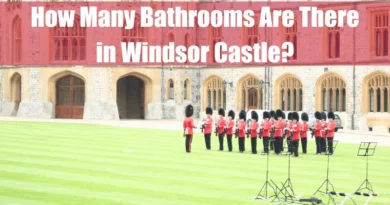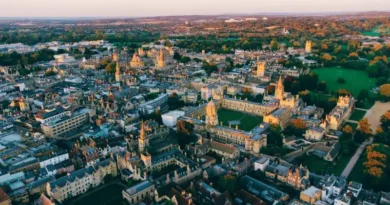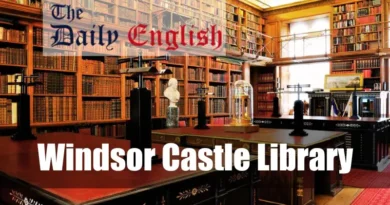Inside Windsor Castle
Takeaways
| Key Points |
|---|
| Windsor Castle’s interiors embody a rich tapestry of history, art, and royal tradition, with each room serving a distinct function and holding immense significance. |
| The grand St. George’s Hall, spanning 180 feet, is famed for its magnificent hammer-beam ceiling adorned with the coats of arms of the Knights of the Garter and serves as the venue for state banquets and the annual Garter Day procession. |
| The opulent Grand Reception Room, designed by Jeffry Wyatville for George IV, features gilded mouldings, crystal chandeliers, and exquisite furnishings, making it ideal for official receptions and state occasions. |
| The King’s and Queen’s State Bedchambers, though no longer in use for their original purposes, showcase ornate four-poster beds, intricate tapestries, and significant artworks, offering a glimpse into past royal lifestyles. |
| Additionally, the Semi-State Rooms, used by Queen Elizabeth II for official entertainment, and the Private Apartments, reserved for the reigning monarch, further emphasise the castle’s dual role as a ceremonial venue and royal residence, with spaces such as the Private Chapel and Royal Library reflecting the monarchy’s artistic and intellectual heritage. |
Introduction to Windsor Castle’s Interiors
Windsor Castle, established in the 11th century by William the Conqueror, stands as a testament to centuries of architectural transformation. Initially constructed as a motte-and-bailey fortress, it has evolved into a grand royal residence. Over the years, monarchs have left their marks, resulting in a blend of medieval fortifications and modern restorations. Significant modifications during the reigns of George IV and Queen Victoria introduced new design elements, reflecting the changing tastes of the British monarchy.
The interiors of Windsor Castle have always played a pivotal role in royal ceremonies and daily life. These spaces are integral to the monarchy’s public and private functions, from hosting state banquets to serving as private retreats. The design and decoration of each room are meticulously planned to convey power, tradition, and the personal tastes of reigning monarchs. The State Apartments, for instance, are adorned with artworks and furnishings that reflect the nation’s history and the monarchy’s enduring legacy.
The State Apartments

St. George’s Hall
Architectural Features and Historical Significance
St. George’s Hall is one of the most significant rooms within Windsor Castle. Spanning 180 feet in length, it showcases a magnificent hammer-beam ceiling adorned with the coats of arms of the Knights of the Garter. This hall has been the backdrop for numerous state banquets and official events, underscoring its importance in royal protocol.
Notable Events and Ceremonies Held
Over the centuries, St. George’s Hall has hosted a myriad of significant events. Notably, it serves as the venue for the annual Garter Day procession and banquet, celebrating the Order of the Garter, the oldest order of chivalry in the United Kingdom. Additionally, it has been used for state dinners honouring visiting dignitaries and has witnessed numerous royal celebrations and ceremonies.
The Grand Reception Room
Design Elements and Furnishings
The Grand Reception Room epitomizes opulence. Originally designed by architect Jeffry Wyatville for George IV, the room features gilded mouldings, crystal chandeliers, and intricate ceiling paintings. The furnishings include exquisite French and English pieces, reflecting the grandeur of the Georgian era.
Role in Royal Functions
This room is primarily used for official receptions and state occasions. Its grandeur makes it an ideal setting for welcoming foreign dignitaries and hosting large gatherings. The room’s design and decor are intended to impress guests, showcasing the wealth and cultural sophistication of the British monarchy.
The King’s State Bedchamber
Historical Context and Furnishings
The King’s State Bedchamber, though no longer used for its original purpose, offers insight into the ceremonial aspects of royal life. Historically, such rooms were used for the ritual of the royal levee, where courtiers would attend the monarch as he dressed. The room is furnished with a grand four-poster bed, ornate tapestries, and period furniture, reflecting the era’s tastes.
Artistic Highlights
Adorning the walls are portraits of past monarchs and notable figures painted by renowned artists of the time. The intricate plasterwork on the ceiling and the richly woven tapestries add to the room’s artistic significance, making it a highlight for visitors interested in royal art collections.
The Queen’s State Bedchamber
Design and Decoration
The Queen’s State Bedchamber mirrors the elegance of its counterpart. Decorated in soft hues with delicate silk wall coverings, the room exudes a sense of refined luxury. The furnishings include an ornate bed, elegant chairs, and finely crafted tables, all arranged to create a harmonious and inviting space.
Notable Artworks and Artifacts
This chamber houses several notable artworks, including portraits of queens and princesses and exquisite artefacts such as fine porcelain and decorative items that reflect the personal tastes of the royal occupants. These pieces offer a glimpse into the private lives of the monarchy and their appreciation for art and culture.
The Semi-State Rooms
Purpose and Function
The Semi-State Rooms were created for George IV as private apartments and are still used by the monarch for official entertaining. These rooms are more intimate than the grand State Apartments and offer a glimpse into the personal spaces of the royal family.
Distinctive Features and Furnishings
Each room within the Semi-State Apartments is uniquely decorated, featuring rich colours, luxurious fabrics, and ornate furnishings. Notable rooms include the Crimson Drawing Room and the Green Drawing Room, each named for their distinctive colour schemes.
Distinctive Features and Furnishings
The Semi-State Rooms at Windsor Castle are among the most richly decorated interiors in the Castle. These private apartments, created for George IV, feature interiors decorated by Morel & Seddon, incorporating furnishings and fittings from Carlton House, George IV’s former London residence.
The Crimson Drawing Room, a principal room in the Semi-State apartments, is decorated to a design by Morel and Seddon. It contains notable examples of furniture and state portraits of King George VI and Queen Elizabeth.
These rooms were used by Queen Elizabeth II for official entertaining, reflecting their continued importance in royal functions.
The Semi-State Rooms are open to visitors during the winter months, providing a glimpse into the private apartments created for George IV.
In summary, the Semi-State Rooms at Windsor Castle stand as a testament to George IV’s vision and the era’s craftsmanship. Their distinctive features and furnishings continue to captivate visitors, offering a window into the opulent world of the British monarchy.
Private Apartments
Windsor Castle’s Private Apartments serve as the personal quarters for the reigning monarch and select royal family members. These areas, while not typically accessible to the public, are integral to the daily life and functions of the monarchy.
The Private Chapel
Architectural Style and Significance
The Private Chapel within Windsor Castle exemplifies Gothic architectural elements, featuring pointed arches, ribbed vaults, and detailed stone carvings. This intimate space has been the site of numerous personal religious ceremonies for the royal family, underscoring its importance in their spiritual life.
Notable Artworks and Stained Glass
The chapel houses several significant artworks, including intricate stained glass windows that depict various biblical scenes and saints. These windows not only enhance the chapel’s aesthetic appeal but also serve as a testament to the rich artistic heritage of the Castle.
The Royal Library
Collection Highlights
The Royal Library at Windsor Castle boasts an extensive collection of books, manuscripts, and artworks. Among its treasures are rare volumes, historical documents, and a notable collection of drawings by renowned artists.
Historical Development
Established over centuries, the library has evolved from a modest collection to a vast repository of knowledge and art. It reflects successive monarchs’ intellectual pursuits and interests, serving as a window into the scholarly inclinations of the British royal family.
The Royal Dining Room
Design and Decor
The Royal Dining Room is adorned with opulent furnishings, including a grand dining table, elegant chairs, and exquisite tableware. The walls are often decorated with portraits and tapestries, contributing to an atmosphere of regal splendour.
Notable Events and Dinners
This room has hosted numerous significant events, including state banquets and private family gatherings. Its ambience and decor have witnessed many historical moments, making it a place of both ceremonial importance and personal significance for the royal family.
Specialized Rooms
Beyond the private apartments, Windsor Castle contains several specialized rooms, each with its unique purpose and historical context.
The Waterloo Chamber

Historical Context and Design
King George IV commissioned the Waterloo Chamber as a tribute to the defeat of Napoleon at the Battle of Waterloo in 1815. Designed by architect Sir Jeffry Wyatville during the 1820s, the chamber was intended to commemorate the Allied victory and the ensuing peace in Europe. The room is adorned with portraits by Sir Thomas Lawrence, depicting key figures involved in the battle and the peace negotiations.
Role in Royal Ceremonies
Beyond its commemorative purpose, the Waterloo Chamber serves as a venue for significant royal events. It is frequently used for investiture ceremonies, where individuals are honoured for their contributions to society. The chamber’s grandeur and historical significance provide a fitting backdrop for these prestigious occasions.
The Garter Throne Room

Architectural Features
Created during George IV’s extensive renovations of Windsor Castle, the Garter Throne Room showcases the opulent design characteristic of the period. The room features an elaborate ceiling and rich furnishings, displaying the royal throne. Portraits of monarchs and heraldic symbols associated with the Order of the Garter adorn the walls, emphasizing its connection to this esteemed order.
Significance in the Order of the Garter
The Garter Throne Room is central to the traditions of the Order of the Garter, Britain’s oldest and most senior order of chivalry. During the Order’s annual ceremony, the Sovereign formally invests new Companions with the Order’s insignia in this room each June. The investiture is followed by a grand procession to St. George’s Chapel within Windsor Castle for a service, underscoring the room’s importance in the chivalric traditions of the British monarchy.
These rooms not only exemplify the architectural splendour of Windsor Castle but also play pivotal roles in the ceremonial and historical tapestry of the British monarchy.
Art and Furnishings
Windsor Castle houses an extensive art collection and furnishings, reflecting centuries of royal patronage and taste.
Royal Collection Highlights
Notable Paintings and Sculptures
The Royal Collection at Windsor Castle includes significant works from the Italian Renaissance, such as Annibale Carracci’s “The Agony in the Garden” and Giovanni Bellini’s “Portrait of a Young Man.” These masterpieces are displayed in the State Apartments, offering visitors a glimpse into the rich artistic heritage of the monarchy.
Decorative Arts and Antiques
Beyond paintings and sculptures, the Castle’s interiors are adorned with exquisite examples of porcelain, furniture, and other decorative arts. Many of these pieces were commissioned or acquired by monarchs to enhance the aesthetic appeal of the State Apartments.
Furnishing Windsor Castle
Historical Development of Interior Furnishings
The evolution of Windsor Castle’s interior furnishings mirrors the changing tastes and styles of successive monarchs. Each era has left its mark on the Castle’s decor, from the baroque grandeur of Charles II’s State Apartments to the modern restorations following the 1992 fire.
Notable Designers and Craftsmen
Throughout its history, Windsor Castle has benefited from the expertise of renowned designers and craftsmen. For instance, the restoration efforts after the 1992 fire involved skilled artisans who meticulously recreated damaged interiors, ensuring the preservation of the Castle’s historical integrity.
Conservation and Restoration
Preserving Windsor Castle’s architectural and artistic heritage requires ongoing conservation and restoration efforts.
Post-Fire Restoration Efforts
In 1992, a devastating fire caused extensive damage to Windsor Castle, destroying 115 rooms, including nine State Rooms. The subsequent restoration project faced significant challenges, such as accurately reconstructing historical interiors and sourcing appropriate materials. Despite these obstacles, the restoration was completed on schedule and within budget, leading to the Castle’s reopening in 1997.
Ongoing Conservation Practices
Today, the Royal Collection Trust employs modern techniques and materials to ensure the Castle’s preservation. Advanced fire detection and suppression systems have been installed, and sustainable practices are utilized in ongoing maintenance. The Trust plays a crucial role in safeguarding the Castle’s structural and artistic elements for future generations.
Visitor Experience
Windsor Castle offers visitors a comprehensive experience of its historic interiors.
Guided Tours of Interior Spaces
Various guided tours are available, providing insights into the Castle’s history, architecture, and art collections. Highlights include the State Apartments, St. George’s Chapel, and Queen Mary’s Dolls’ House. These tours offer a unique opportunity to explore the Castle’s rich heritage.
Seasonal Decorations
Windsor Castle is adorned with festive decorations during the holiday season, enhancing the visitor experience. For instance, a 20-foot Christmas tree is displayed in St. George’s Hall, and other rooms feature seasonal adornments. These decorations add a celebratory atmosphere to the historic setting.
Conclusion
Windsor Castle’s interiors offer a profound insight into the British monarchy’s history, art, and traditions. From its remarkable art collections and meticulously crafted furnishings to its resilient restoration efforts and engaging visitor experiences, the Castle stands as a testament to centuries of cultural heritage. Exploring its halls provides not only a journey through architectural and artistic splendours but also a deeper appreciation of the enduring legacy that Windsor Castle represents.
FAQ
What are the State Apartments in Windsor Castle?
The State Apartments are a series of grand rooms used for official events and ceremonies. They feature opulent decorations, priceless artworks, and exquisite furnishings, reflecting centuries of royal history. Notable rooms include the Grand Reception Room and St George’s Hall.
Can I visit Queen Mary’s Dolls’ House inside Windsor Castle?
Yes, Queen Mary’s Dolls’ House is a highlight of the Castle. This intricate 1:12 scale model showcases a miniature royal residence complete with working utilities and detailed furnishings, offering a unique glimpse into early 20th-century aristocratic life.
What is the Semi-State Rooms’ significance?
The Semi-State Rooms are private apartments created for George IV. Lavishly decorated, they are used by the monarch for official entertaining. These rooms are open to the public during winter when the State Apartments are not in use.
Are there any exhibitions inside Windsor Castle?
Windsor Castle hosts various exhibitions throughout the year, showcasing items from the Royal Collection. These exhibits offer insights into the monarchy’s history, art, and culture. You should check the official website for current exhibitions during your visit.
What can I see in the Drawings Gallery?
The Drawings Gallery displays changing exhibitions of drawings and watercolours from the Royal Collection. Past exhibits have included works by Leonardo da Vinci and other masters, providing a glimpse into the artistic heritage preserved within the Castle.
Is the Changing of the Guard ceremony held inside Windsor Castle?
Yes, the Changing of the Guard takes place within the castle grounds. This ceremonial event involves the handover of duties between guards and is accompanied by a military band. It’s a popular attraction for visitors.
Are there dining facilities inside Windsor Castle?
While there are no dining facilities within the Castle itself, the nearby town of Windsor offers a variety of restaurants and cafés to suit different tastes and budgets.
Can I take photographs inside Windsor Castle?
Photography is prohibited inside the State Apartments or St George’s Chapel to protect the artworks and maintain security. However, you are welcome to take photos of the Castle’s exterior and the surrounding grounds.
Is there a dress code for visiting Windsor Castle?
There is no formal dress code for general visitors. However, as St George’s Chapel is a place of worship, it’s respectful to dress modestly when entering the chapel.
Are audio guides available inside Windsor Castle?
Yes, complimentary audio guides are provided with your admission ticket. They offer detailed information about the Castle’s history, architecture, and treasures, enhancing your visit.
Is Windsor Castle accessible to visitors with disabilities?
Windsor Castle offers facilities to assist visitors with disabilities, including step-free access routes, accessible toilets, and wheelchairs available for loan. It’s recommended to contact the Castle in advance to discuss specific needs.
Are there guided tours inside Windsor Castle?
While there are no guided tours, the complimentary audio guides provide an informative and flexible way to explore the Castle at your own pace. Additionally, wardens are available throughout the Castle to answer questions.
What is the Moat Room in Windsor Castle?
The Moat Room houses a bronze model of Windsor Castle as it appeared in 1377. It features a timeline detailing the Castle’s development and the reigns of successive monarchs, offering visitors a comprehensive overview of its rich history.
Can I attend services at St George’s Chapel within Windsor Castle?
Yes, visitors are welcome to attend services at St George’s Chapel. While the chapel is closed to visitors on Sundays, worshippers may attend services held throughout the day. Service times are available on the chapel’s website.









